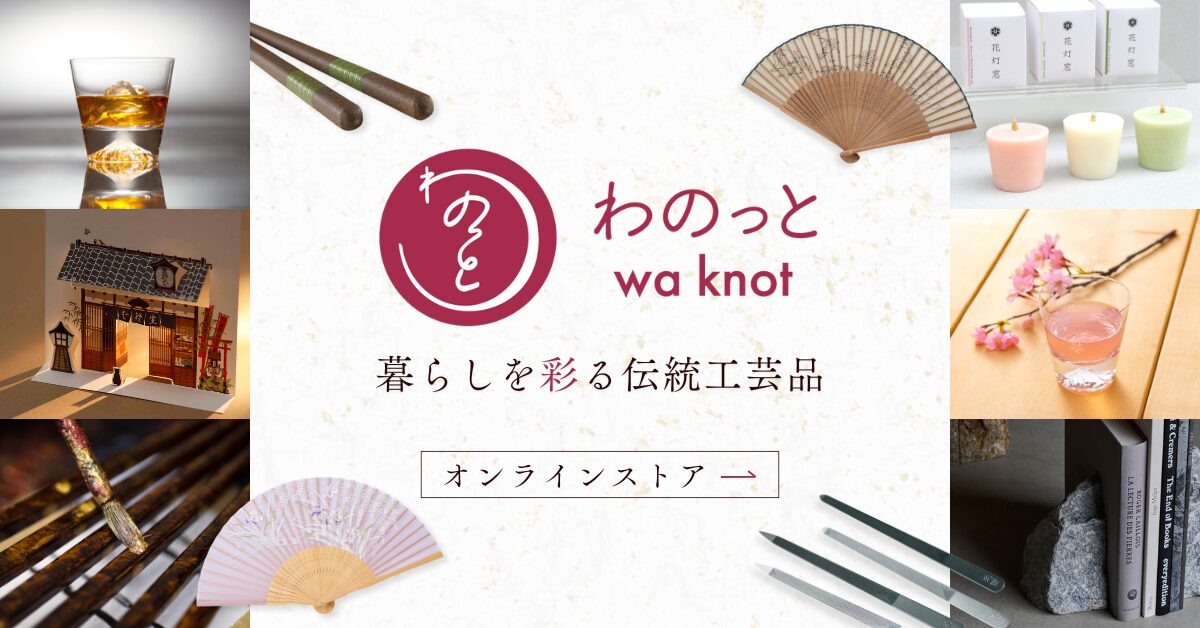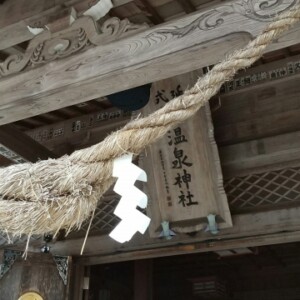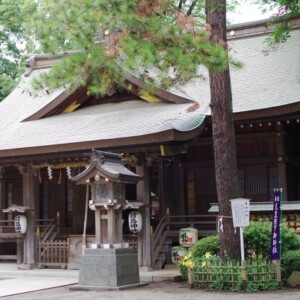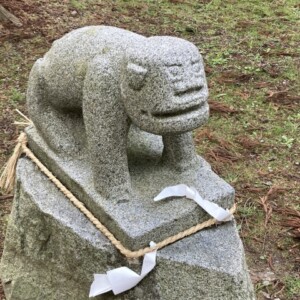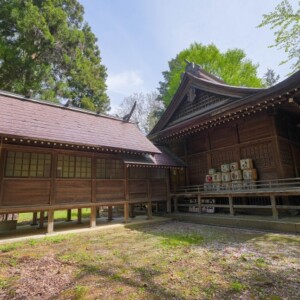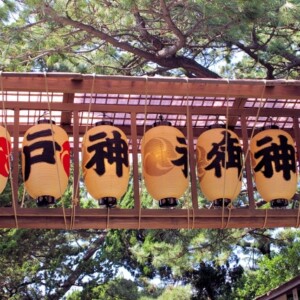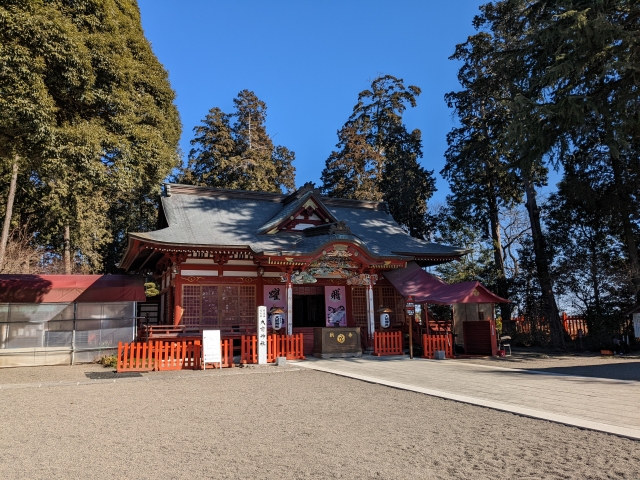
Omae Shrine|A complete guide to the charms, highlights, and worship at this Engishiki-Unaisha shrine with 1,500 years of history
Omae Shrine, located in a lush forest in Moka City, Tochigi Prefecture, has been worshipped by many people since ancient times as a Engi-shiki-no-uchi-sha shrine with a history of over 1,500 years. The shrine is well known as a shrine of good luck and invitations to good fortune, enshrining Daikoku-sama and Ebisu-sama, and the main shrine, with its beautiful carvings in rich colors, is designated as an important cultural property of Japan. The shrine also boasts the largest statue of Ebisu-sama in Japan, and is known as a popular power spot where visitors come from all over the country to pray for winning the lottery.
Outline and basic information about Omae Shrine
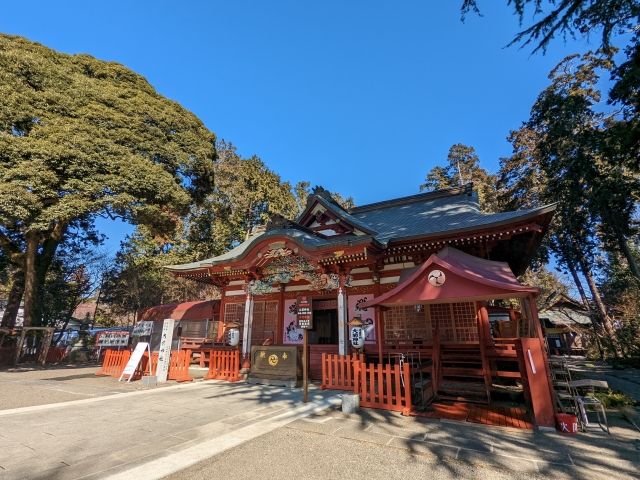
Omae Shrine is an old shrine with a record of having been rebuilt during the Jingo-Keiun period (767-770), and is a historic shrine mentioned in the Engishiki Shinmei Jocho compiled in the Heian period (794-1185). The name “Omae” is said to have originated from the fact that the shrine was located on the edge of the large Haganuma Swamp that once existed to the north of the shrine grounds, hence the name “Omae (saki) Shrine.
Locals have long been familiar with the name “Omae-sama” or “Omae Daigongen,” and many people still refer to the shrine by the names “Gongen-sama” or “Omae-sama. There is a historical anecdote that in 935, Taira no Masakado prayed for victory in a battle during the Jouhei Tenkei Rebellion, and since ancient times the shrine has been believed to be a place of long military fortune and good luck.
History and Origin
Omae Shrine is said to have been founded in the ancient times as a sacred site of the Shinto Era. The earliest documented reconstruction of the shrine is dated to the Jingo-Keiun period, but the actual history of the shrine is much older, and it was already recognized as an important shrine in the Heian period (794-1185) as Engi-shiki-uchi-sha.
In the Middle Ages, the Haga clan, a powerful warrior clan from the Bando region, served as the shrine’s guardians and protected the Omae Shrine territory for 22 generations. The Haga clan built Wakashiki Castle to the east of the shrine and Gozen Castle to the south, and ruled the area around the shrine, indicating the importance of Omae Shrine at that time.
During the Heian period (794-1185), the shrine became a branch temple of Kuroko Senmyoji Temple on Toeizan in Bando, Hitachinaka Province, and Yakushi Nyorai was also enshrined there in accordance with the syncretism of Shinto and Buddhist teachings. In the Edo period (1603-1867), as the faith of the common people increased, the present beautiful group of shrine buildings were constructed, which greatly influenced the development of decorative architecture in the Kanto region.
Gods and Benefits
The deities of Omae Shrine are Daikoku-sama, the deity of good fortune, and his son, Kotoshironushi-sama (Ebisu-sama). Amaterasu and the other eight million gods are also enshrined as deities, making Omae Shrine a sacred place where all the gods of Japan are gathered in one place.
Daikoku-sama is also known as the main deity of Izumo-taisha Shrine, and is believed to bring a wide range of benefits such as marriage, domestic safety, prosperous business, and agricultural promotion. Kotoshironushi-taijin, also known as Ebisu-sama, is believed to be the god of prosperous business, financial fortune, fishing, and maritime safety, and is especially believed in by people engaged in business.
These two deities are also called “Nifukujin” (two gods of fortune), and many visitors come to the shrine to receive blessings in all aspects of life, including good fortune, health, marriage, healing of illness, and safety in the home. In recent years, the shrine has also become the focus of much attention for its lottery winning opportunities, and people from all over Japan visit the shrine to make their wishes known.
Omae Shrine Highlights
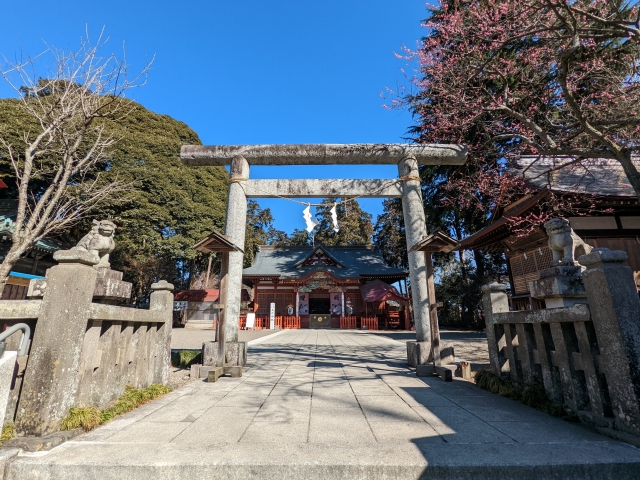
The main attraction of Omae Shrine is the splendid group of shrine pavilions built in the early to mid-Edo period. The main hall, the hall of worship, and the hall of offerings are all designated as national important cultural properties, and are highly regarded as masterpieces of decorative architecture in the Kanto region. The giant 20-meter-high statue of the deity Ebisu-sama, erected in 1989, is affectionately known as “Japan’s No.1 Ebisu-sama” and is a source of great amusement to many visitors.
The murmuring of the Gogyo River that runs along the east side of the shrine grounds and the beauty of the kanko-ume plum blossoms that bloom in early spring are other attractions of Omae Shrine. In this environment rich in nature, it is a precious space where visitors can enjoy both the historic architecture and the natural beauty of the four seasons at the same time.
Architectural and Structural Attractions
The main hall of Omae Shrine was built in 1707, and the hall of worship and the hall of offerings were constructed in the late 17th century by carpenters with excellent skills invited from all over the Kanto region. These structures are regarded as the forerunners of the decorative architectural beauty that developed from Nikko Toshogu Shrine to the eastern part of Japan, and are precious remains that show the early stage of richly decorated shrine architecture in the northern Kanto region.
The main hall is an irimoya style with a gabled gabled roof with a girder length of 3 ken and a beam length of 2 ken. The main hall is an irimoya-style structure with a girder length of 3 ken (3 ken) and a beam length of 2 ken (2 ken), and has a single room for a muko-ha (a prayer room). These decorations were pioneering at the time, and the building is highly regarded as an important example of the budding popularity of decorative architecture in the Kanto region.
The worship hall features a large number of carvings around the front shrine and a staggered gable on the roof, creating a gorgeous space for worship. The theme of the sculpture group, decorated with extreme colors, is “hermaphrodites and the blessings of water,” and “water deities” wishing for the future of the building and sacred sacred animals and birds expressing the power of the deities are skillfully placed. These sculptures were created by master craftsmen Magoheiji Fujita and Entei Shimamura, and are a valuable cultural heritage that conveys the superior craftsmanship of the Edo period to the present day.
Japan’s No. 1 Ebisu Shrine and Omae Ebisu Shrine
Omae Ebisu Shrine, a Wakamiya Shrine within the Omae Shrine precincts, houses a huge 20-meter-high statue of Ebisu-sama, which was completed on December 10, 1989. The statue was dedicated to Omae Ebisu Shrine by local volunteers and is known as “Japan’s No.1 Ebisu-sama.
The shrine pavilion is set up inside the Oya stone pedestal, and on the night of December 9, 1989, a splitting ceremony was held to enshrine the spirit of Kotoshironushi (Ebisu-sama) from the Omae Shrine, the head shrine. The shrine’s deity is Kotoshironushi (Ebisu-sama).
The deity attracts many worshippers, especially those who come to pray for a winning lottery ticket. There are many reports of people actually winning the lottery, and many votive ema (votive picture tablet) are dedicated in the temple grounds. The temple serves as a true power spot for worshippers who wish for prosperous business and good fortune.
A group of highly colored sculptures and important cultural assets
The group of extremely colorful sculptures on the main hall, worship hall, and mihiden of Omae Shrine was designated as a National Important Cultural Property on December 25, 2018, as a masterpiece of the best decorative architectural techniques of the Edo period. These sculptures are not mere decoration, but a precious cultural heritage with both deep religious significance and artistic value.
The sculptures in the main hall are decorated with numerous sacred spirit animals and birds, including dragons, expressing the power and majesty of the gods. In particular, the dragon carvings on the braided structure are superbly done, and their dynamic appearance overwhelms the viewer. The pillars and walls are decorated with geometric carvings, which bring a sense of unity and beauty to the entire building.
The worship area is decorated with sculptures of hermits and water blessings, symbolizing the hope that the building will be inherited by the power of the water god for many years to come. These sculptures are painted with extreme colors, and the vivid colors of vermilion, gold, and blue harmoniously blend together to create a solemn and beautiful space.
These decorative architectural structures show the early stage of the rapid spread of richly decorated shrine architecture in the northern Kanto region against the backdrop of popular beliefs, and are of great historical value in understanding the process of technological and design development.
Guide to Worship and Visiting the Shrine
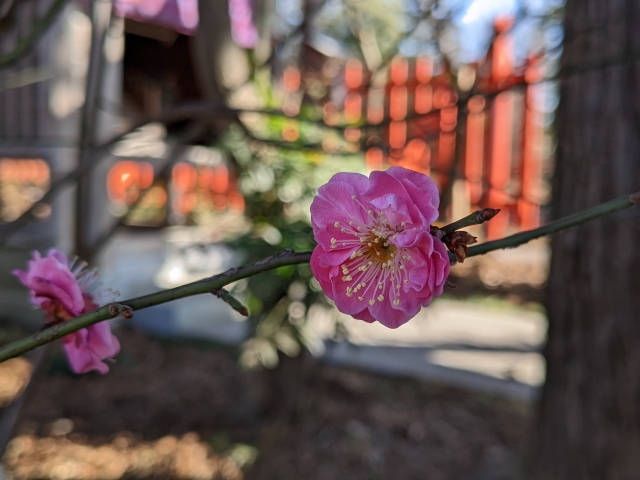
Omae Shrine offers a variety of ways to worship to the divine virtues of Daikoku-sama and Ebisu-sama. In addition to general visitation, prayers for life’s milestones and wishes are accepted at any time, and many visitors offer their prayers with all their hearts. The temple grounds are open for worship 24 hours a day, and a particularly sacred atmosphere can be felt during the quiet hours of early morning and evening.
The festivals and events held throughout the year are another attraction of Omae Shrine. Especially during the annual grand festival, the Daitai Kagura, designated as a cultural asset by Moka City, is performed, allowing visitors to experience up close the solemnity of the ancient Shinto rituals.
Worship Etiquette and Manners
Worship at Omae Shrine is conducted in accordance with general shrine etiquette. When entering the shrine grounds, bow before the torii gate and walk down the path, avoiding the center of the path. After purifying your body and mind at the water closet, you should bow in front of the hall of worship in the manner of “ni-ai niha, niha te, ippai” (two cheers, one bow).
The official order of worship at Omae Shrine is to first visit the Omae Shrine, the main shrine, and then visit Omae Ebisu Shrine (the most Ebisu shrine in Japan), the Wakamiya Shrine on the shrine grounds. It is believed that by praying wholeheartedly to each of the deities, one will receive deeper blessings.
If you wish to pray, fill out an application form at the prayer reception desk and pay the first earning fee. Prayers are accepted from 8:30 a.m. to 4:20 p.m. at any time. Prayers are offered for family safety, traffic safety, prosperous business, protection from bad luck, directional protection, good marriage, physical health, success in school, good luck, and easy delivery, etc. Prayers are offered carefully according to each wish.
Annual & Seasonal Events
Omae Shrine holds a variety of festivals and events throughout the year. The three most important festivals are the Prayer Festival (March 28), the Regular Festival (November 9 and 10), and the Shinnae Festival (November 27), during which a grand kagura performance is held in the Kaguraden.
Daitai Kagura is a Shinto ritual that is said to have been handed down from Ise Jingu Shrine in the mid-Edo period and consists of 26 dances of the gods. The “Daikoku Ebisu no Mai”, “Tenkusu Shirakusu no Mai”, and “Amano no Iwato no Mai” are especially noteworthy, and are performed to pray for good luck, peace on earth, a good harvest, and prosperity of descendants.
In the spring, the beautiful red plum blossoms on the temple grounds are in full bloom, delighting the eyes of worshippers. The shrine also holds limited events on special days each month. Special red seals and good luck charms are distributed on Ichibanmabuhi Day, and a Tanabata Festival is held in July, during which visitors can dedicate strips of paper with their wishes on them.
On the third day of the New Year, the temple grounds are crowded with visitors for Hatsumode (New Year’s visit), especially those who come to pray for a winning lottery ticket to Japan’s No.1 Ebisu-sama. Special sacred cards and amulets are also awarded at this time of year, and many visitors offer their prayers with their wishes for the New Year.
Red Seal and Good Luck Charm Information
Omae Shrine offers a wide variety of charms and red seals associated with the deities Daikoku-sama and Ebisu-sama. The most popular is the “lucky charm,” which is a good luck charm with a design of the deity’s image. Since a worshipper who received this amulet won a large sum of money, the shrine receives inquiries from all over the country about the amulet as a good luck charm for winning a lottery.
Other charms are available for various wishes, such as the “Houou Mamori” (Phoenix Protection), which was made in commemoration of the designation as a National Important Cultural Property, the “Shiawase Koi Mamori” in the shape of a carp, which is the messenger of the deity of the shrine, and the “Shindori-Kokeshi Mamori” for traffic safety. Also popular are “Sukusuku-mamori” and “Randoseru-mamori” to wish for the healthy growth of children.
In addition to the regular red seals, red seals are also available only for seasonal and special occasions. The red seals with animal motifs are also popular, especially the white snake red seal and the rice-grain-shaped red seal available only on the “Ichigumanbai” day attract many visitors. Red seals are available from 8:30 a.m. to 5:00 p.m.
For those who live far from the shrine, red seals can also be conferred by mail, and can be applied for by special application form, fax, or document mailing. For sacred fuda, the shrine also offers a set of sacred fuda for the altar, including Omae Shrine’s sacred fuda, Jingu Omari (shrine marijuana) and fireless prayer fuda, as well as wooden fuda for specific wishes.
Access/Use Information
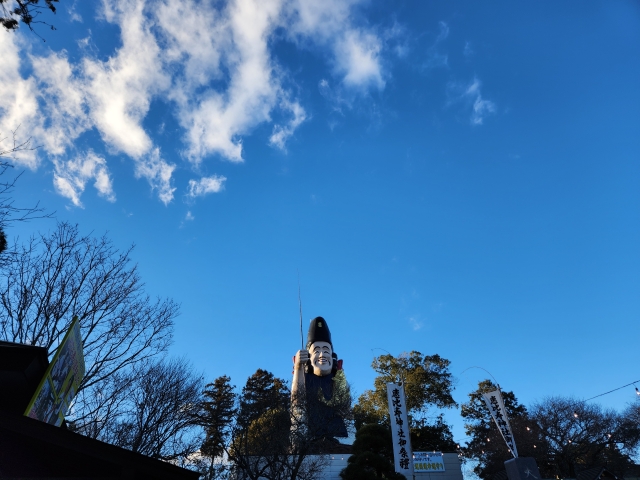
The most convenient way to access Omae Shrine is by private car. It is about 15 minutes from the Moka Interchange on the Kita-Kanto Expressway, and about 50 minutes from the Utsunomiya area. If you use public transportation, it is about a 15-minute walk from Kita-Mooka Station on the Mooka Railway Mooka Line.
There are several free parking lots within the precincts of the shrine, with a total capacity of approximately 200 vehicles. However, since crowding is expected during events such as Hatsumode (New Year’s visit to the shrine) and major festivals, early arrival is recommended.
Traffic Access
When coming by car, the nearest interchange is the Moka Interchange on the Kita-Kanto Expressway. It takes about 15 minutes from the interchange via Route 408. From the direction of Utsunomiya, there is also a route via Route 294 from Route 4, which takes about 50 minutes.
If coming by train, transfer from JR Utsunomiya Station to the Moka Tetsudo Moka Line, get off at Kita-Maoka Station, and walk about 15 minutes. Moka Tetsudo also operates an SL train mainly on weekends, allowing visitors to enjoy a train trip with a retro atmosphere.
By bus, take the Kanto Bus bound for “Utsunomiya Tobu – Moka Office” from JR Utsunomiya Station, and get off at the Omae-jinja-mae stop, which is a short walk away. Please check the timetable in advance, as the number of buses is limited.
The road to the shrine grounds is well-maintained, and group visits by large buses are possible. If you wish to visit the shrine in a group, please contact the shrine in advance for more information.
Hours of Operation, Fees, and Parking
Omae Shrine is open to visitors 24 hours a day, and there are no specific fees to visit the shrine. However, the awarding office is open from 8:45 a.m. to 5:00 p.m. Please come during these hours to receive a red seal or amulet. Prayer services are available anytime from 8:30 a.m. to 4:20 p.m.
There are several parking lots around the temple grounds, all of which are free of charge. They can accommodate approximately 200 standard-sized vehicles and can also accommodate large buses. Temporary parking is also available during busy times such as Hatsumode and the annual festival, but please allow plenty of time for your visit as the lot may be full.
The temple grounds are barrier-free and wheelchair-accessible. However, there are stairs around the main shrine, so if you need assistance, please let us know in advance and we will guide you.
Omae Shrine also holds a treasure and antique market on the second Sunday of each month (not held in January and November), which can be enjoyed in conjunction with the shrine visit. This is a valuable opportunity to deepen exchanges with local people.
<Address> 937 Togo, Moka-shi, Tochigi 321-4306
Reference site
Omae Shrine official website: https://oosakijinja.com/
Omae Ebisu Shrine, the most Ebisu-sama shrine in Japan: https://ebisujinja.com/


